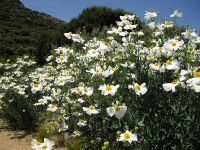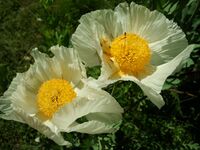Biology:Romneya coulteri
| Romneya coulteri | |
|---|---|

| |
| Scientific classification | |
| Kingdom: | Plantae |
| Clade: | Tracheophytes |
| Clade: | Angiosperms |
| Clade: | Eudicots |
| Order: | Ranunculales |
| Family: | Papaveraceae |
| Genus: | Romneya |
| Species: | R. coulteri
|
| Binomial name | |
| Romneya coulteri Harv.
| |
Romneya coulteri, the Coulter's Matilija poppy[1] or California tree poppy, is a perennial species of flowering plant in the poppy family Papaveraceae. Native to southern California , USA, and Baja California, Mexico, it grows in dry canyons in chaparral and coastal sage scrub plant communities, sometimes in areas recently burned.[2] It is a popular ornamental plant, kept for its large, showy flowers.
The specific epithet coulteri commemorates Thomas Coulter, an Irish botanist and explorer.[3]
This herbaceous perennial[4] may exceed 2 m (7 ft) in height, its stem growing from a network of rhizomes. The gray-green, waxy-textured leaves are each divided into a few lance-shaped lobes, the blades growing up to 20 centimeters (7.8 in) long. The inflorescence is a large, solitary flower with six crinkly white petals each up to 10 cm (4 in) long. At the center of the flower is a cluster of many yellow stamens. The fruit is a bristly capsule, 3–4 cm (1–2 in) long, containing many tiny seeds.
This plant often grows aggressively once planted. It spreads clonally by underground rhizomes and can appear several feet away from the original plant.[5]
This plant bears the largest flowers of any species native to California, rivaled only by Hibiscus lasiocarpos.[6] It was nominated for the honor of California state flower in 1890, but the California poppy won the title in a landslide.[7]
In cultivation in the UK, Romneya coulteri and the cultivar ‘White Cloud’[8] have gained the Royal Horticultural Society’s Award of Garden Merit.[4][9]
Chemical composition
Protopine is the major alkaloid of this plant, followed by coulteropine and romneine.[10]
Gallery
References
- ↑ "Romneya coulteri". Natural Resources Conservation Service PLANTS Database. USDA. https://plants.usda.gov/core/profile?symbol=ROCO. Retrieved 22 October 2015.
- ↑ California Native Plant Society Rare Plant Profile
- ↑ Harrison, Lorraine (2012). RHS Latin for gardeners. United Kingdom: Mitchell Beazley. pp. 224. ISBN 9781845337315.
- ↑ 4.0 4.1 "RHS Plantfinder - Romneya coulteri ". https://www.rhs.org.uk/Plants/21715/i-Romneya-coulteri-i/Details. Retrieved 10 October 2018.
- ↑ "Wildflowers, NPS, SAMO NRA - Romneya coulteri detail page". http://www.smmflowers.org/bloom/species/Romneya_coulteri.htm.
- ↑ Flora of North America
- ↑ Clark, C. Genus Eschscholzia: History
- ↑ "RHS Plantfinder - Romneya coulteri 'White Cloud'". https://www.rhs.org.uk/Plants/74133/i-Romneya-coulteri-i-White-Cloud/Details. Retrieved 10 October 2018.
- ↑ "AGM Plants - Ornamental". Royal Horticultural Society. July 2017. p. 88. https://www.rhs.org.uk/plants/pdfs/agm-lists/agm-ornamentals.pdf. Retrieved 9 October 2018.
- ↑ Stermitz, F.R.; Chen, L.; White, J.I. (1966). "Alkaloids of the papaveraceae—II". Tetrahedron 22 (3): 1095–1102. doi:10.1016/0040-4020(66)80085-6. ISSN 0040-4020.
External links
| Wikimedia Commons has media related to Romneya coulteri. |
- Pink, A. (2004). Gardening for the Million. Project Gutenberg Literary Archive Foundation. https://www.gutenberg.org/ebooks/11892.
- Jepson Manual Treatment
- Photo gallery
Wikidata ☰ Q3018989 entry
 |



